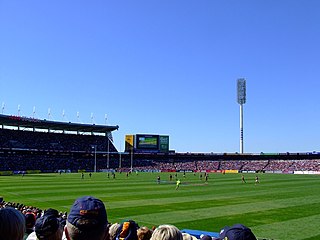
Football Park, known commercially as AAMI Stadium, was an Australian rules football stadium located in West Lakes, a western suburb of Adelaide, the state capital of South Australia, Australia. It was built in 1973 by the South Australian National Football League (SANFL) and opened in 1974. Until the end of the 2013 AFL season, it served as the home ground of South Australia's AFL clubs, the Adelaide Football Club and Port Adelaide Football Club. It also hosted all SANFL finals from 1974 to 2013. Demolition of the stadium's grandstands began in August 2018, and finished in March 2019.

Canberra Stadium is a facility primarily used for rugby league and rugby union games, located adjacent to the Australian Institute of Sport in Canberra, the capital of Australia. It is the largest sports venue by capacity in Canberra.

Kardinia Park is a sporting and entertainment venue located within Kardinia Park, South Geelong, in the Australian state of Victoria. The stadium, which is owned and operated by the Kardinia Park Stadium Trust, is the home ground of the Geelong Football Club, an Australian rules football club who compete in the Australian Football League (AFL). Kardinia Park can accommodate 40,000 spectators, making it the largest-capacity Australian stadium in a regional city.

Moore Park is a suburb in the Eastern Suburbs of Sydney located 3 kilometres (1.9 mi) from the CBD, in the state of New South Wales, Australia. It is part of local government area of the City of Sydney.

The Brisbane Cricket Ground, commonly known as the Gabba, is a major sports stadium in Brisbane, the capital of Queensland, Australia. The nickname Gabba derives from the suburb of Woolloongabba, in which it is located. Over the years, the Gabba has hosted athletics, Australian rules football, baseball, concerts, cricket, cycling, rugby league, rugby union, Association football and pony and greyhound racing. At present, it serves as the home ground for the Queensland Bulls in domestic cricket, the Brisbane Heat of the Big Bash League and Women's Big Bash League, and the Brisbane Lions of the Australian Football League. It is also the secondary home of the Brisbane Broncos of the National Rugby League. The stadium will receive an upgrade for the 2032 Summer Olympics and Paralympics.

Jubilee Stadium is a multi-purpose stadium in Carlton, a suburb in Sydney, Australia. The stadium is mainly used for rugby league and the A-League, and is one of the home grounds of the National Rugby League (NRL) team St. George Illawarra Dragons. The stadium has hosted football matches, including hosting Sydney Olympic FC in the 2003–04 National Soccer League and recently, Sydney FC in the 2018–19, 2019–20 A-League, 2020–21 and 2021–22 due to the rebuild of the Sydney Football Stadium. The Cronulla Sutherland Sharks temporarily played at Netstrata Jubilee Stadium during the major redevelopment of their leagues club and stadium in 2020-21.

Victoria Park is a sports venue in Abbotsford, a suburb of Melbourne in Victoria, Australia. The stadium is oval shaped and was built to host Australian rules football and cricket matches. In the past Victoria Park featured a cycling track, tennis courts, and a baseball club that once played curtain raisers to football matches.
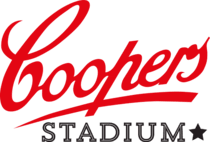
Hindmarsh Stadium is a multi-purpose stadium in Hindmarsh, an inner western suburb of Adelaide, South Australia. It is the home of the Australian A-League team, Adelaide United.

Parramatta Stadium was a sports stadium in Parramatta, New South Wales, Australia, 24 km (15 mi) west of Sydney CBD. The stadium was the home ground of several western Sydney-based sports teams, at the time of closure the most notable were the Parramatta Eels of the National Rugby League and the Western Sydney Wanderers of the A-League.

Olympic Park Stadium was a multi-purpose outdoor stadium located on Olympic Boulevard in inner Melbourne, Australia. The stadium was built as an athletics training venue for the 1956 Olympics, a short distance from the Melbourne Cricket Ground, which served as the Olympic Stadium. Over the years it was the home of rugby league side, Melbourne Storm and the A-League team, Melbourne Victory; throughout its life the stadium played host to athletics. Olympic Park Stadium was located in Olympic Park, which is part of the Melbourne Sports and Entertainment Precinct.

Henson Park is a multi purpose sports ground in Marrickville, New South Wales, Australia.
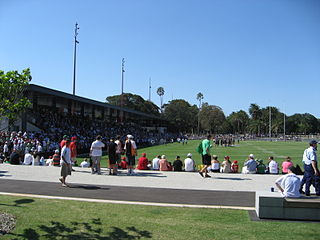
Redfern Oval is an Australian football ground, in the Sydney suburb of Redfern, New South Wales, Australia. The South Sydney Rabbitohs Rugby League Football Club played at Redfern Oval between 1948 and 1987. Rabbitoh supporters often refer to Redfern Oval as "The Holy Land".

Blacktown International Sportspark (BISP) (formally known as Blacktown Olympic Park) is a multi-sports venue located in Rooty Hill, a suburb in Sydney, Australia. The venue includes two cricket grounds, which have also been used for Australian rules football, an athletics track and field, three baseball diamonds, two soccer fields, four softball diamonds, administration centers and park land.

North Dalton Park is located on Pioneer Rd, Towradgi, in the northern suburbs of Wollongong, New South Wales, Australia.
Bicentennial Park South, currently known as Rockdale Ilinden Sports Centre, is a football (soccer) stadium in Rockdale, a suburb of Sydney in New South Wales, Australia.
Barlow Park is a multi-sports facility and stadium in Parramatta Park, Cairns, Queensland, Australia.
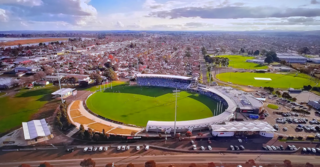
Eureka Stadium, known commercially as Mars Stadium, is an oval-shaped sports stadium located in the Eureka Sports Precinct of Wendouree, 2.9 km (1.8 mi) north of the CBD of the city of Ballarat, Victoria, Australia.
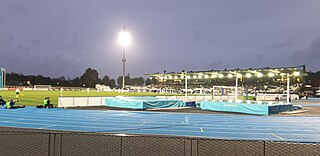
Lakeside Stadium is an Australian sports arena in the South Melbourne suburb of Albert Park. Comprising an athletics track and soccer stadium, it currently serves as the home ground and administrative base for association football club South Melbourne FC, Athletics Victoria, Athletics Australia, Victorian Institute of Sport and Australian Little Athletics.

Sydney Showground Stadium is a sports and events stadium located at the Sydney Showground in Sydney Olympic Park suburb of Sydney, New South Wales, Australia. It hosted the baseball events for the 2000 Summer Olympics. The Showground, including the stadium, is operated by the Royal Agricultural Society of NSW (RAS), under lease from the New South Wales Government.
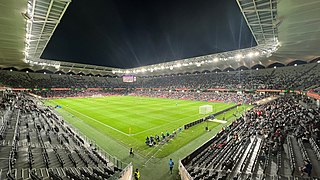
Western Sydney Stadium, commercially known as CommBank Stadium, is a multi-purpose rectangular stadium in Parramatta, within the Greater Western Sydney region, approximately 24 km (15 mi) west of Sydney CBD. It replaced the demolished Parramatta Stadium (1986) which in turn was built on the site of the old Cumberland Oval, home ground to the Parramatta Eels since 1947. The current stadium opened in April 2019 and has a 30,000-seat capacity. The stadium is owned by the NSW Government and built at a cost of $300 million. The stadium hosts games across the major rectangular field sports in Sydney.



















